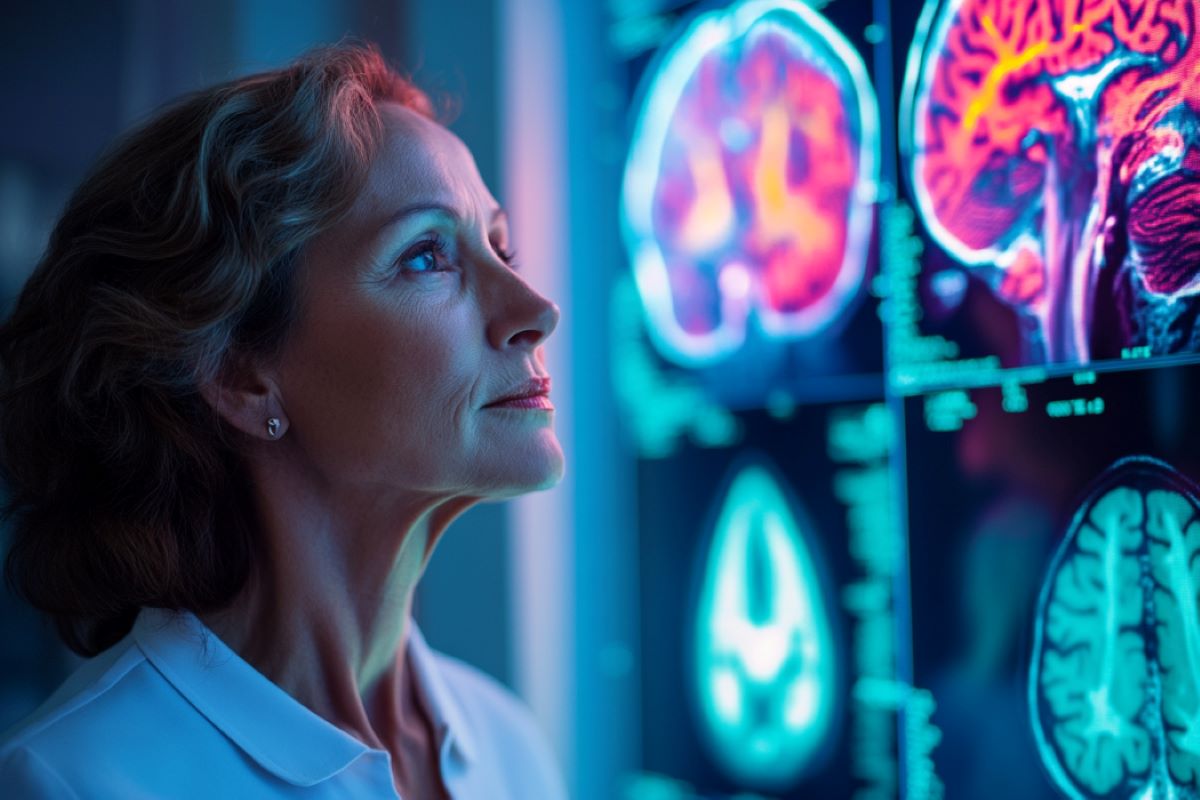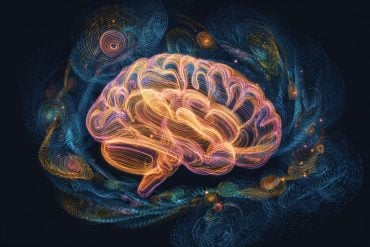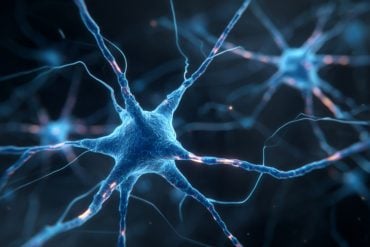Summary: Menopausal hormone therapy (MHT) has nuanced effects on brain health, influenced by factors like age, treatment duration, and past surgical history. The study found that current MHT users had higher brain age gaps and smaller hippocampal volumes, while past users showed no significant differences compared to non-users.
Additionally, women who stopped MHT later in life or used it longer had larger brain age gaps. These findings highlight the need for personalized approaches to MHT use, considering its varying impact on brain health.
Key Facts:
- MHT’s effect on brain health depends on age, duration, and surgical history.
- Current MHT users had older brain age gaps and smaller hippocampal volumes.
- Personalized MHT approaches are necessary due to its complex brain effects.
Source: eLife
A study suggests that menopausal hormone therapy (MHT) might have moderate effects on brain health, but this depends on past surgical history, the duration of treatment, and a woman’s age at last use.
The research, published October 8 as a Reviewed Preprint in eLife, was described by editors as an important investigation, using a solid model of brain ageing, into the associations between MHT and brain health in a large population of UK women.
The work addresses a topic that the editors say is of grave importance, since MHT and its effect on the brain needs to be better understood, to provide effective and individualised medical support to women going through menopause.

Ovarian hormones such as oestrogens and progesterone fluctuate throughout a woman’s lifespan, and particularly during the years preceding menopause when ovarian function starts to decline.
MHT is often prescribed to minimise the symptoms of these fluctuations during the menopausal transition and is commonly thought to protect the brain and reduce the risk of Alzheimer’s disease, but the evidence to support this is conflicting.
“Mixed findings from previous studies of MHT and brain health raise the question of whether a combination of timing, formulation and route of administration might play a crucial role in the effectiveness of MHT,” says lead author Claudia Barth, a researcher in the Division for Mental Health and Substance Abuse at Diakonhjemmet Hospital, Oslo, Norway.
“In this study, we investigated links between MHT variables, different MHT regimes, genetic factors, and brain measures in middle-to older aged women.”
The researchers used data from the UK Biobank, which contains de-identified genetic, lifestyle and health information and biological samples. They analysed data from nearly 20,000 women who had MRI brain scans and were either current or past users of MHT or had never used MHT at all, most of whom reported to have passed menopause.
They studied brain MRI images to determine the ‘brain age gap’ – the difference between chronological and brain age – as well as other proxies of brain health.
The team says the results were puzzling. Women who had taken MHT in the past had no significant difference in brain age to never-users. But women who were current MHT users had on average higher grey and white-matter brain age gaps – indicating their brain age was older than their actual chronological age – than women who had never taken MHT. They also had smaller left and right hippocampus brain volumes.
Moreover, amongst past users, the age the women were when they last took MHT made a difference. Those who were older at the time of their last use after menopause had a higher brain age gap and lower hippocampal volumes. Similar results were found for women who took MHT for a longer duration.
Women on MHT who had surgery to remove their womb and/or both ovaries had a lower brain age gap than women on MHT without the same surgical history. And unexpectedly, there was no difference in MHT-related variables such as dose or active ingredients, whether it was synthetic or bioidentical, or taken as a pill or a patch.
The researchers also assessed whether a known risk gene for Alzheimer’s disease, called APOE ɛ4, influenced the effect of MHT on proxies of brain health and found no link here either.
In considering the results, the authors commented that while some modest adverse brain health characteristics were associated with current MHT use and women being an older age at last use, the findings do not support a general neuroprotective effect of MHT nor severe adverse effects on the female brain.
“The results suggest subtle yet complex relationships between MHT use and brain health, highlighting the necessity for a personalised approach to MHT use,” Barth says.
“Importantly, our analyses provide a broad view of population-based associations and are not designed to guide individual-level decisions regarding the benefits versus risks of MHT use.”
The authors add that current MHT users were significantly younger than past and never-users and around a lower proportion were postmenopausal (67% versus 80%), suggesting that a larger proportion of these women may have been in perimenopause which is often associated with neurological symptoms such as cognitive decline and mood changes.
The need for MHT might therefore be an indicator of neurological changes during this transition, which then stabilise later in life, they suggest.
“Our results indicate that the effect of MHT on female brain health might vary depending on factors including timing, duration of use and past surgical history,” concludes senior author Ann Marie de Lange, Senior Research Fellow in the Department of Clinical Neurosciences, Lausanne University Hospital, Switzerland.
“However, our study is cross-sectional and we cannot establish causality. Future studies mapping the long-term impacts of MHTs on brain health are of immense importance to understand individual risk profiles and benefits.
“Women worldwide face critical decisions regarding MHT use, yet the current lack of comprehensive research leaves them without the necessary evidence to make informed choices.”
About this HRT and brain health research news
Author: Emily Packer
Source: eLife
Contact: Emily Packer – eLife
Image: The image is credited to Neuroscience News
Original Research: Open access.
“Menopausal hormone therapy and the female brain: leveraging neuroimaging and prescription registry data from the UK Biobank cohort” by Claudia Barth et al. eLife
Abstract
Menopausal hormone therapy and the female brain: leveraging neuroimaging and prescription registry data from the UK Biobank cohort
Background and Objectives
Menopausal hormone therapy (MHT) is generally thought to be neuroprotective, yet results have been inconsistent. Here, we present a comprehensive study of MHT use and brain characteristics in middle-to older aged females from the UK Biobank, assessing detailed MHT data, APOE ε4 genotype, and tissue-specific gray (GM) and white matter (WM) brain age gap (BAG), as well as hippocampal and white matter hyperintensity (WMH) volumes.
Methods
A total of 19,846 females with magnetic resonance imaging data were included (current-users = 1,153, 60.1 ± 6.8 years; past-users = 6,681, 67.5 ± 6.2 years; never-users = 12,012, mean age 61.6 ± 7.1 years). For a sub-sample (n = 538), MHT prescription data was extracted from primary care records. Brain measures were derived from T1-, T2- and diffusion-weighted images.
We fitted regression models to test for associations between the brain measures and MHT variables including user status, age at initiation, dosage and duration, formulation, route of administration, and type (i.e., bioidentical vs synthetic), as well as active ingredient (e.g., estradiol hemihydrate). We further tested for differences in brain measures among MHT users with and without a history of hysterectomy ± bilateral oophorectomy and examined associations by APOE ε4 status.
Results
We found significantly higher GM and WM BAG (i.e., older brain age relative to chronological age) as well as smaller left and right hippocampus volumes in current MHT users, not past users, compared to never-users. Effects were modest, with the largest effect size indicating a group difference of 0.77 years (∼9 months) for GM BAG. Among MHT users, we found no significant associations between age at MHT initiation and brain measures.
Longer duration of use and older age at last use post menopause was associated with higher GM and WM BAG, larger WMH volume, and smaller left and right hippocampal volumes. MHT users with a history of hysterectomy ± bilateral oophorectomy showed lower GM BAG relative to MHT users without such history. Although we found smaller hippocampus volumes in carriers of two APOE ε4 alleles compared to non-carriers, we found no interactions with MHT variables.
In the sub-sample with prescription data, we found no significant associations between detailed MHT variables and brain measures after adjusting for multiple comparisons.
Discussion
Our results indicate that population-level associations between MHT use, and female brain health might vary depending on duration of use and past surgical history. Future research is crucial to establish causality, dissect interactions between menopause-related neurological changes and MHT use, and determine individual-level implications to advance precision medicine in female health care.







